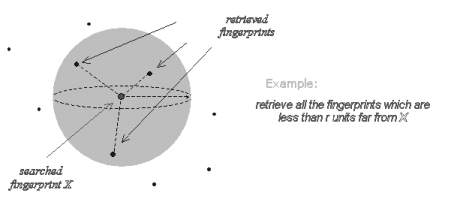|

Home

People

Research

Publications

Resources

Related Links
|
|
Continuous ClassificationThe main problem of exclusive classification schemes is that the number of classes is low and fingerprints are unevenly distributed among them: more than 90% of the fingerprints belong to three classes (left loop, right look and whorl). In ten-print identification (where an individual has to be identified using information from her ten fingers), this does not compromise the efficiency too much, since the knowledge of the classes of all the fingerprints can be used as a distinctive code for reducing the number of comparisons; on the other hand, when a single fingerprint has to be searched in a large database, then the exclusive classification stage is not able to narrow down the search enough. Furthermore, when classification is performed automatically, errors and rejected fingerprints needs to be taken into account.
For applications where it is not necessary to comply with an existing classification scheme, in 1997 BioLab introduced the "Continuous Classification" approach. In continuous classification, each fingerprints is associated to a point in a multidimensional space through a similarity-preserving transformation, such that similar fingerprints correspond to close points. During the retrieval, the fingerprints considered are only those whose corresponding points are within a given radius from the query fingerprint: this allows the problems due to ambiguous fingerprints to be avoided and the tradeoff between accuracy and efficiency to be adjusted according to the application requirements (by changing the search radius). 
Bibliography(Click here if you are interested in any of the publications below) | D. Maltoni, D. Maio, A.K. Jain and J. Feng, Handbook of Fingerprint Recognition (Third Edition), Springer Nature, 2022. |  | D. Maltoni, D. Maio, A.K. Jain and S. Prabhakar, Handbook of Fingerprint Recognition (Second Edition), Springer (London), 2009. |  | R. Cappelli and D. Maio, "The State of the Art in Fingerprint Classification", in N. Ratha and R. Bolle, Automatic Fingerprint Recognition Systems, Springer, 2004.  Abstract Abstract |  | R. Cappelli, "Fast and Accurate Fingerprint Indexing based on Ridge Orientation and Frequency", IEEE Transactions on Systems, Man and Cybernetics - Part B, vol.41, no.6, pp.1511-1521, December 2011.  Abstract Abstract |  | R. Cappelli, M. Ferrara and D. Maio, "Candidate List Reduction based on the Analysis of Fingerprint Indexing Scores", IEEE Transactions on Information Forensics and Security, vol.6, no.3, pp.1160-1164, September 2011.  Abstract Abstract |  | R. Cappelli, M. Ferrara and D. Maltoni, "Fingerprint Indexing based on Minutia Cylinder-Code", IEEE Transactions on Pattern Analysis Machine Intelligence, vol.33, no.5, pp.1051-1057, May 2011.  Abstract Abstract |  | R. Cappelli, D. Maio and D. Maltoni, "A Multi-Classifier Approach to Fingerprint Classification", Pattern Analysis and Applications Special Issue on Fusion of Multiple Classifiers, vol.5, no.2, pp.136-144, May 2002.  Abstract Abstract |  | R. Cappelli, A. Lumini, D. Maio and D. Maltoni, "Fingerprint Classification by Directional Image Partitioning", IEEE Transactions on Pattern Analysis Machine Intelligence, vol.21, no.5, pp.402-421, May 1999.  Abstract Abstract |  | A. Lumini, D. Maio and D. Maltoni, "Continuous vs Exclusive Classification for Fingerprint Retrieval", Pattern Recognition Letters, vol.18, no.10, pp.1027-1034, October 1997.  Abstract Abstract |  | R. Cappelli, D. Maio and D. Maltoni, "Indexing Fingerprint Databases for Efficient 1:N Matching", in proceedings Sixth International Conference on Control, Automation, Robotics and Vision (ICARCV2000), Singapore, December 2000. Invited Paper.  Abstract Abstract |  | R. Cappelli, D. Maio and D. Maltoni, "Combining Fingerprint Classifiers", in proceedings First International Workshop on Multiple Classifier Systems (MCS2000), Cagliari, pp.351-361, June 2000.  Abstract Abstract |  | A. Lumini, D. Maio and D. Maltoni, "Strategie per il retrieval di impronte digitali", in proceedings Sistemi Evoluti per Basi di Dati (SEBD97), Verona (Italy), pp.47-66, June 1997.   Abstract Abstract |
|


